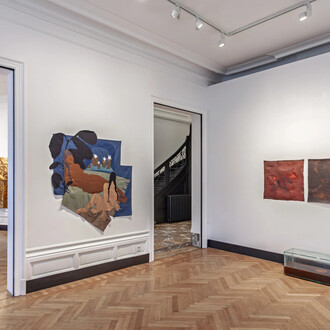Sven Lukin, a major figure of the New York avant-garde, was one of the pioneers of the Shaped Canvas movement in the 1960s.
Born in Riga, Latvia, in 1934, Lukin immigrated to the United States in 1949 and studied at the University of Pennsylvania in Philadelphia, where he was mentored by the renowned architect Louis Kahn. His career began to flourish in the early 1960s, with exhibitions at Betty Parsons Gallery and later Martha Jackson Gallery, before he was represented exclusively by Pace Gallery, which held four solo exhibitions of his work between 1963 and 1972. In 1972, Lukin chose to step away from the commercial art world, continuing to work independently and privately for the rest of his life.
Lukin’s most celebrated works date from the 1960s: minimalist, three-dimensional abstract paintings—colorful shaped canvases that extend beyond the wall into space and architecture. His most iconic piece remains the undulating 36-meter-long wall installation in green, pink, and orange at Albany’s Empire State Plaza, a permanent public commission that epitomizes his vision.
The fifty years following his withdrawal from the public art scene in the early 1970s have contributed to the aura of mystery surrounding his career. Once widely acclaimed, Lukin’s work has since become something of an enigma, sustained by a small circle of devoted admirers who have continued to explore and preserve his legacy.
I count myself among these admirers. I have been captivated by Sven Lukin’s work for many years. Through the artist Andy Robertson—Lukin’s occasional assistant—I was introduced to Ronald Winston, a longtime friend, collector, and guardian of the artist. Thanks to them, I had the privilege of meeting Sven Lukin shortly before his passing. I extend my deepest gratitude to both of them.
Lukin lived and worked in the same studio from 1960 until the end of his life. When I visited this space, I expected nothing more than to meet one of my artistic heroes. As I explored the dense, layered environment—filled with fifty years of accumulated material—I discovered, hanging high on the walls, a group of around twenty extraordinary works that immediately captured my imagination.
These were Shaped Canvases whose stretchers were made from tree branches, covered with burlap. Some were left raw, others painted with geometric patterns. This body of work marks a radical departure from his earlier production, yet it reveals a continuity of core concerns: the interplay between painted surface and physical form, the movement of color through space, and the ongoing dialogue between painting and sculpture.
What sets these later works apart is their direct engagement with nature—a kind of devolution from the pop-modernist optimism of the 1960s toward a more archaic, ritualistic understanding of art. Lukin, ever enigmatic, spoke little about these pieces during our conversation, only hinting that they were created in the 1990s.
These polygonal, irregular, shield-like forms stretched over branches resonate with naturalist, Native American, and modernist influences, while also evoking a shamanic tradition that Lukin traced back to his grandfather’s heritage.
With this exhibition, I am honored to pay tribute to a historical artist who deserves renewed recognition, and to shed light on this remarkable and little-known body of work by Sven Lukin—known as Branches.
(Text by Sébastien Janssen)















